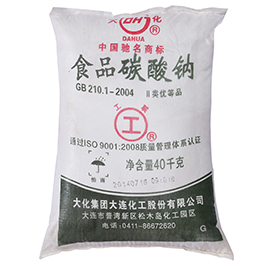Food Industry
Home-Product-Food Industry-Food Industry

Soda ash (sodium carbonate)
Shape appearance:
Sodium carbonate is a white odorless powder or granule at room temperature.
Product Usage:
It is an important organic chemical raw material, mainly used in the production of flat glass, glass products and ceramic glaze. It is also widely used in household washing, acid neutralization and food processing.
Sodium carbonate is a white odorless powder or granule at room temperature.
Product Usage:
It is an important organic chemical raw material, mainly used in the production of flat glass, glass products and ceramic glaze. It is also widely used in household washing, acid neutralization and food processing.
- Previous:
- Food grade hydrogen peroxide
- Next:
- Activated carbon
Product Description
recautions for storage
Store in a cool, ventilated warehouse. Keep away from fire and heat sources. It should be stored separately from acids, etc., and avoid mixed storage. The storage area should be equipped with suitable materials to contain the leakage.
Incompatible materials: strong acid, aluminum, fluorine
Transportation considerations
The packaging should be complete when shipping, and the loading should be secure. During transportation, ensure that the container does not leak, collapse, fall, or be damaged. Mixed shipment and transportation with acids and edible chemicals are strictly prohibited. Avoid exposure to the sun, rain, and high temperature during transportation. The vehicle should be thoroughly cleaned after transportation.
The product is weakly irritating and weakly corrosive. Direct contact can cause skin and eye burns. Inhalation of its dust and smoke during production can cause respiratory irritation and conjunctivitis, as well as nasal mucosal ulcers, atrophy and perforation of the nasal septum. Prolonged contact with the product solution can cause eczema, dermatitis, corn ulcers and loose skin. The incidence of respiratory diseases in workers exposed to this product has increased. Ingestion by mistake can cause burns of the digestive tract, mucosal erosion, bleeding and shock.
usage notice
1. Wear appropriate protective clothing and gloves.
2. After accidental contact with eyes, please rinse immediately with plenty of water and seek medical advice.
3. Do not inhale dust.
4. Wear appropriate protective clothing.
5. Wear goggles or masks.
6. Harmful if swallowed.
7. Irritating to eyes.
8. Toxic to aquatic organisms and may cause long-term adverse effects on the water environment.
9. Irritating to eyes, respiratory system and skin.
10. Irritating to the respiratory system and skin.
11. Serious damage to eyes.
Store in a cool, ventilated warehouse. Keep away from fire and heat sources. It should be stored separately from acids, etc., and avoid mixed storage. The storage area should be equipped with suitable materials to contain the leakage.
Incompatible materials: strong acid, aluminum, fluorine
Transportation considerations
The packaging should be complete when shipping, and the loading should be secure. During transportation, ensure that the container does not leak, collapse, fall, or be damaged. Mixed shipment and transportation with acids and edible chemicals are strictly prohibited. Avoid exposure to the sun, rain, and high temperature during transportation. The vehicle should be thoroughly cleaned after transportation.
The product is weakly irritating and weakly corrosive. Direct contact can cause skin and eye burns. Inhalation of its dust and smoke during production can cause respiratory irritation and conjunctivitis, as well as nasal mucosal ulcers, atrophy and perforation of the nasal septum. Prolonged contact with the product solution can cause eczema, dermatitis, corn ulcers and loose skin. The incidence of respiratory diseases in workers exposed to this product has increased. Ingestion by mistake can cause burns of the digestive tract, mucosal erosion, bleeding and shock.
usage notice
1. Wear appropriate protective clothing and gloves.
2. After accidental contact with eyes, please rinse immediately with plenty of water and seek medical advice.
3. Do not inhale dust.
4. Wear appropriate protective clothing.
5. Wear goggles or masks.
6. Harmful if swallowed.
7. Irritating to eyes.
8. Toxic to aquatic organisms and may cause long-term adverse effects on the water environment.
9. Irritating to eyes, respiratory system and skin.
10. Irritating to the respiratory system and skin.
11. Serious damage to eyes.






 13603024855
13603024855 Follow us
Follow us